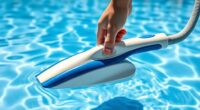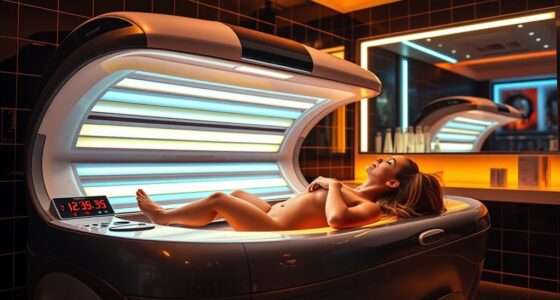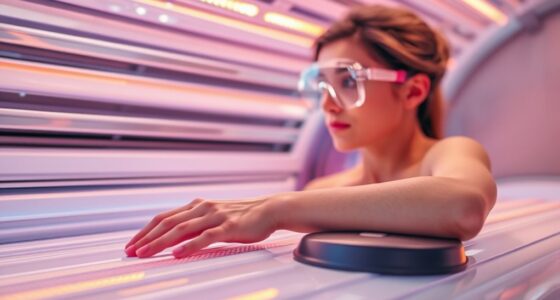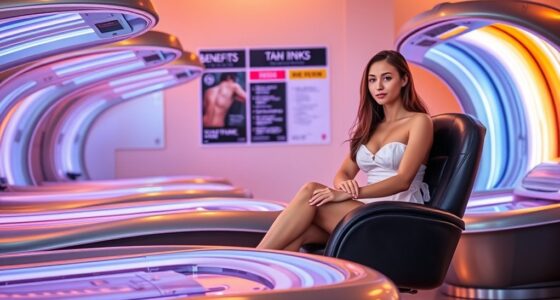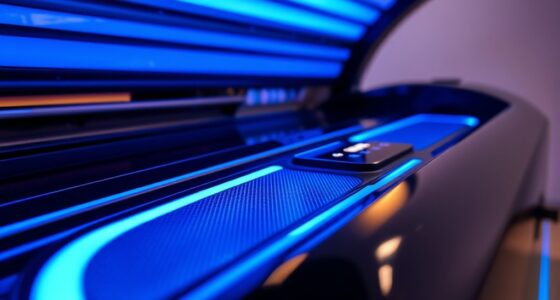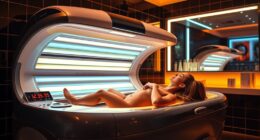Tanning beds emit artificial ultraviolet (UV) radiation, mainly UVA and UVB, produced by specialized lamps to mimic natural sunlight. When you use them, UV rays penetrate your skin, triggering increased melanin production that causes tanning. However, this exposure can damage your DNA, raising your risk of skin cancer and accelerating aging. Understanding how these devices work and their effects helps you make safer choices—keep going to explore more about this scientific process.
Key Takeaways
- Tanning beds emit UV radiation, primarily UVA and UVB, through mercury vapor or quartz bulbs to induce skin tanning.
- UV exposure causes DNA damage in skin cells, triggering pigmentation but increasing skin cancer risks.
- UVA penetrates deeper, damaging connective tissue and accelerating skin aging, while UVB stimulates melanin production.
- Safety features like timers and shields regulate UV exposure, but prolonged use still poses significant health risks.
- Indoor tanning elevates the risk of skin cancers, including melanoma, and is classified as a Group I carcinogen by WHO.
How Tanning Beds Emit Artificial UV Radiation

Tanning beds produce artificial UV radiation through specialized light sources that mimic the sun’s rays. Most commonly, they use mercury vapor lamps, which emit broad-spectrum UV rays—both UVA and UVB—by passing electric currents through vaporized mercury. The type, size, and intensity of these lamps vary depending on the bed’s design, with high-pressure models using quartz bulbs that emit 10-15 times more UVA than midday sun. The UV output depends heavily on lamp maintenance and technology, aiming to balance rapid tanning with safety. Acrylic shields diffuse the UV light, while reflective interiors maximize exposure efficiency. Timers, cooling systems, and safety features like automatic shutoffs help control session length and prevent overexposure. Overall, the device’s spectral output and delivery mechanisms are carefully engineered to produce consistent UV radiation. Additionally, modern tanning beds often incorporate UV safety features to minimize health risks associated with UV exposure.
The Biological Impact of UV Exposure on Skin Cells
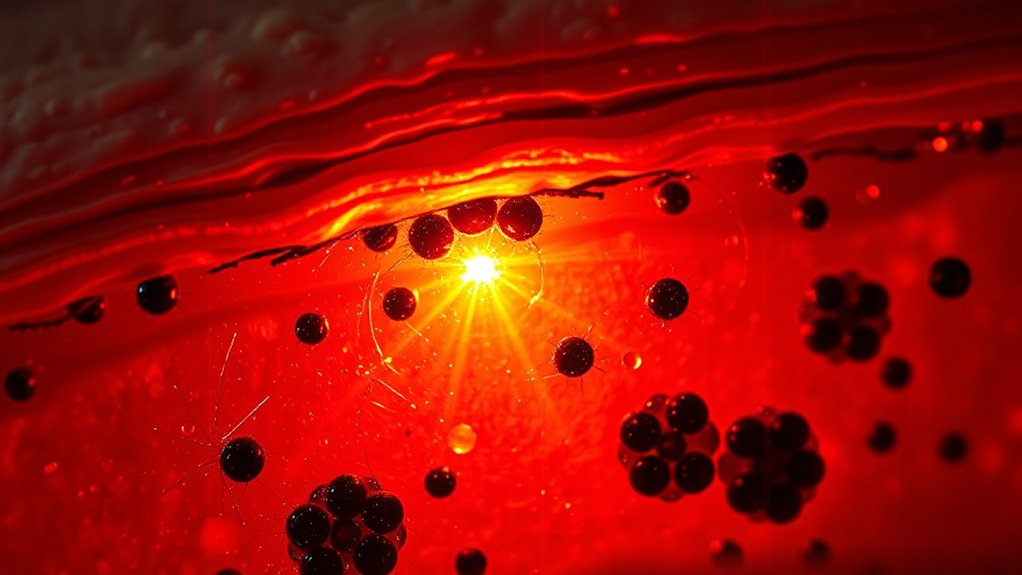
Ultraviolet (UV) radiation from tanning beds directly impacts skin cells by inducing specific biological changes. UV radiation causes DNA damage, creating photolesions that may lead to mutations and skin cancer if left unrepaired. It also triggers apoptosis in damaged cells and activates DNA repair mechanisms to prevent abnormal growth. UVB induces inflammation by releasing cytokines, resulting in sunburn and long-term damage. Additionally, UV exposure increases epidermal cell division, thickening the skin as a protective response. UV-A rays penetrate deeper, damaging connective tissue and reducing elasticity, which accelerates aging, causes wrinkles, and promotes sagging. UV exposure also stimulates melanin production, leading to tanning, but over time, it damages elastin fibers and blood vessels, contributing to premature aging and slower healing. Ongoing research highlights the importance of AI safety measures in developing protective technologies and guidelines for safer tanning practices. Furthermore, understanding the biological impact of UV exposure helps in designing better protective strategies and skincare regimens.
Linking Indoor Tanning to Skin Cancer Risks

Indoor tanning considerably increases your risk of developing skin cancer, including basal cell carcinoma, squamous cell carcinoma, and melanoma. Using tanning beds, especially in early adulthood, notably raises the chances of melanoma and non-melanoma skin cancers. The World Health Organization classifies UV radiation from tanning devices as a Group I carcinogen, placing it alongside tobacco and asbestos. Studies show indoor tanning elevates squamous cell carcinoma risk by 58% and basal cell carcinoma by 24%. UV rays from tanning beds emit levels similar to or stronger than natural sunlight, damaging DNA in skin cells and promoting mutations. This damage can lead to the development and progression of skin cancers, including the dangerous transformation of benign moles into melanoma. Avoiding indoor tanning drastically reduces your skin cancer risk. Additionally, mammography guidelines emphasize the importance of early detection in reducing mortality rates from breast cancer. Understanding UV radiation exposure helps underscore the importance of protective measures against skin damage, especially given the carcinogenic nature of UV radiation from tanning beds. Recognizing how Bitcoin IRA investments can be volatile highlights the importance of risk management in financial planning. Implementing effective security measures, similar to those used in payment processing, can help mitigate risks associated with UV damage and other health hazards.
Factors Influencing Tanning Bed Usage Patterns

Understanding why people choose to use tanning beds involves examining a mix of personal motivations, social influences, and environmental factors. Many users, especially college-aged individuals, believe a tan enhances their appearance and boosts self-confidence. They associate tanned skin with attractiveness and often use tanning beds before special events like weddings or formals. Peer norms heavily influence usage; if friends or social groups tan, you’re more likely to follow suit. Media and cultural beauty standards pressure you to look tanned, while family attitudes can shape your habits. Accessibility also plays a role—many frequent tanning at commercial studios, which are widespread and affordable. Despite knowing the risks, misconceptions persist, and immediate aesthetic rewards often outweigh concerns about long-term health consequences. Additionally, the perception of tanning beds as a quick and controlled way to achieve a desired skin tone aligns with trends in sustainable fashion by emphasizing convenience and personalized experiences. Tanning salons also often advertise customized tanning options, making it easier for users to select their preferred level of tan. Furthermore, the perceived safety of tanning beds compared to natural sun exposure encourages continued use, despite evidence of health risks. Many users also believe that indoor tanning provides a controlled environment, which they see as safer than unpredictable natural sunlight. In fact, some users underestimate the health risks associated with UV exposure from tanning beds, which can lead to increased usage despite potential dangers.
Strategies and Measures to Reduce Tanning Bed-Related Risks

Implementing effective strategies and measures is vital to reduce the health risks associated with tanning bed use. You should always wear mandatory goggles that block 99% of UV rays to protect your eyes from burns and damage, avoiding regular sunglasses which are insufficient. Use protective lip balm and cover sensitive skin areas like tattoos or keloids. Limit sessions to a maximum of 10 minutes initially, with at least 48 hours between sessions to allow DNA repair, and avoid repeated exposure in the same day. Age restrictions are essential; banning minors under 35 helps reduce melanoma risk. Screen for photosensitivity, review medication use, and encourage skin cancer checkups. Educate about UV carcinogenicity, aging effects, and debunk myths like “base tans” offering SPF protection. Enforce timer settings, regulate UVA/UVB ratios, and guarantee proper warning labels and operator training to further minimize risks. Incorporating digital literacy into public health campaigns can enhance awareness of tanning bed dangers and promote safer practices. Additionally, understanding the industry trends helps in developing effective public health messages and regulations. Recognizing the importance of outdoor exposure and natural sunlight can also encourage safer sun habits and reduce reliance on tanning beds. Promoting the use of air purifiers in indoor environments can improve overall air quality and reduce the risk of respiratory issues related to indoor pollutants. Addressing behavioral factors such as peer influence and social norms can significantly improve compliance with safety guidelines and reduce unnecessary exposure.
Frequently Asked Questions
Are There Any Safe Alternatives to Indoor Tanning for Achieving a Tan?
If you’re looking for safe alternatives to indoor tanning, try spray tans, which give you an even glow without UV exposure. Self-tanning lotions, mousses, and bronzing drops also work well, providing natural-looking color. Gradual tanning moisturizers and makeup bronzers offer temporary solutions for quick results. These options are safer, customizable, and better for your skin’s health, helping you achieve a beautiful tan without risking skin damage or cancer.
How Does UV Radiation From Tanning Beds Differ From Natural Sunlight?
You’re asking how UV radiation from tanning beds differs from sunlight, and it’s like comparing a lightning bolt to a flickering candle. Tanning beds often emit up to 12 times more UVA and can have UVB levels similar to the sun, but concentrated intensely. This means you get a much quicker, harsher dose of radiation that speeds up skin damage and cancer risk, far beyond what natural sunlight typically delivers.
What Are the Long-Term Skin Health Effects of Tanning Bed Use?
You should know that long-term tanning bed use damages your skin considerably. It accelerates aging, causing wrinkles, age spots, and loss of elasticity. Every session damages your skin’s DNA, increasing your risk of skin cancers like melanoma, basal, and squamous cell carcinoma. Plus, it weakens your immune system and harms your eyes. Over time, these effects add up, making your skin look older and more vulnerable to serious health issues.
Can Indoor Tanning Help Increase Vitamin D Levels Safely?
You wonder if indoor tanning can boost vitamin D safely. While it can increase your serum vitamin D levels, it’s not a risk-free method. Tanning beds emit UV-A, and some have UV-B, which helps produce vitamin D. However, excessive use raises skin cancer risks, burns, and other health issues. Health experts generally advise against tanning beds for vitamin D, preferring safer options like diet and supplements.
What Policies Exist Worldwide to Regulate Tanning Bed Use?
About 80 countries have implemented policies regulating tanning bed use. You’ll find requirements like registering equipment with authorities, mandatory health warnings, and restrictions for minors—some countries ban minors entirely, others set age limits. Advertising rules often include carcinogenic risk notices. These policies aim to protect consumers from health risks, but regulation varies widely worldwide. As a result, many nations are working toward harmonized standards to better safeguard public health.
Conclusion
Understanding how tanning beds emit UV radiation, and their impact on your skin, is essential. Just like a mirror reflecting your choices, your decisions about tanning can shape your health. By being aware of the risks and adopting safer habits, you can protect your skin from harm. Think of avoiding tanning beds as steering clear of a storm—you’ll stay safer and healthier, keeping your skin glowing naturally and beautifully for years to come.

